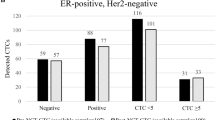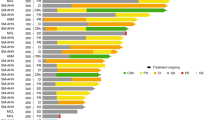Abstract
The expression levels of a circulating extracellular domain of HER-2 can be detected in the plasma and serum of patients with metastatic breast cancer using an enzyme immunoassay (ELISA) method. In this study, we evaluated the clinical significance of high and low levels of HER-2 in the plasma of 46 patients with metastatic breast cancer enrolled in a clinical trial of high-dose chemotherapy (HDCT) using cyclophosphamide, mitoxantrone, and paclitaxel with autologous stem cell transplantation (ASCT). Using 2500 U/ml as the cut-point, 20 patients (46%) had elevated HER-2 levels (HER-2 positive). Our results suggest that patients with metastatic breast cancer and high soluble plasma HER-2 have a significantly poorer overall (OS) and progression-free survival (PFS) following high-dose chemotherapy with paclitaxel and ASCT. The median OS of patients with low levels of HER-2 was significantly longer (P < 0.01) than the median OS of patients with high levels of HER-2 (29.8 months vs 15.9 months). PFS was also significantly longer (P < 0.01) for patients who were HER-2-negative, than for patients who were HER-2-positive (13.0 vs 8.6 months). Univariate analysis showed that patients with liver or lung metastases had significantly reduced OS and PFS. Patients with metastases to two or more sites also had a significantly reduced time to disease progression, but not OS. In multivariable analysis, lung metastases contributed along with HER-2-positive status to determine a group of patients with significantly poorer OS. However, HER-2-positive status remained the only independent predictor of PFS. Bone Marrow Transplantation (2001) 27, 847–853.
This is a preview of subscription content, access via your institution
Access options
Subscribe to this journal
Receive 12 print issues and online access
$259.00 per year
only $21.58 per issue
Buy this article
- Purchase on Springer Link
- Instant access to full article PDF
Prices may be subject to local taxes which are calculated during checkout


Similar content being viewed by others
References
Yu D, Hung M-C . HER-2/neu gene in human cancers. In: Freireich E, Stass SA (eds) Molecular Basis of Oncology vol. 5: Blackwell Scientific: Cambridge 1995 pp 131–162
Slamon DJ, Clark GM, Wong SG et al. Human breast cancer: correlation of relapse and survival with amplification of the HER-2/neu oncogene Science 1987 235: 177–182
Slamon DJ, Godolphin W, Jones LA et al. Studies of the HER-2 /neu proto-oncogene in human breast and ovarian cancer Science 1989 244: 707–712
Lipton A, Ali SM, Leitzel K et al. Elevated serum HER-2/neu level predicts decrease response to hormone therapy in metastatic breast cancer Proc Am Soc Clin Oncol 2000 19: Abstr. 274
De Laurentiis M, Arpino G, Massarelli E et al. A metanalysis of the interaction between Her2 and the response to endocrine therapy (ET) in metastatic breast cancer (MBC) Proc Am Soc Clin Oncol 2000 19: Abstr. 300
Ross JS, Fletcher J . The HER-2/neu oncogene in breast cancer: prognostic factor, predictive factor and target for therapy Stem Cells 1998 16: 413–428
Bewick M, Chadderton T, Conlon M et al. Expression of C-erbB-2/HER-2 in patients with metastatic breast cancer undergoing high-dose chemotherapy and autologous blood stem cell support Bone Marrow Transplant 1999 24: 377–384.
Nieto Y, Cagnoni PJ, Nawaz S et al. Evaluation of the predictive value of Her-2/neu overexpression and p53 mutations in high-risk primary breast cancer patients treated with high dose chemotherapy and autologous stem cell transplantation J Clin Oncol 2000 18: 2070–2080
Ferraresi V, Milella M, Vaccaro A et al. Toxicity and activity of docetaxel in anthracycline-pretreated breast cancer patients: a phase II study Am J Clin Oncol 2000 23: 132–139
Maiche AG, Jekunen AP, Kaleva-Kerola J, Blanco-Sequeiros G . High response rate with a lower dose of paclitaxel in combination with cisplatin in heavily pretreated patients with advanced breast carcinoma Cancer 2000 88: 1863–1868
Greinix HT, Linkesch W, Seifert M et al. Paclitaxel-containing high-dose chemotherapy in high-risk breast cancer patients Acta Oncol 2000 39: 47–52
Burstein HJ, Manola J, Younger J et al. Docetaxel administered on a weekly basis for metastatic breast cancer J Clin Oncol 2000 18: 1212–1219
Gluck S, Germond C, Lopez P et al. High-dose paclitaxel, cyclophosphamide and mitoxantrone followed by autologous blood stem cell support for the treatment of metastatic breast cancer: a phase I trial Eur J Cancer 1998 34: 1008–1014
Kaplan EL, Meier P . Nonparametric estimation from incomplete observations J Am Stat Assoc 1958 53: 457–481
Cox DR . Regression models and life-tables (with discussion) J Roy Stat Soc Ser B, 1972 34: 187–220
Paik S, Bryant J, Park C et al. ErbB-2 and response to doxorubicin in patients with axillary lymph node-positive, hormone receptor negative breast cancer J Natl Can Inst 1998 90: 1361–1370
Muss HB, Thor AD, Berry DA et al. C-erbB-2 expression and response to adjuvant therapy in women with node-positive early breast cancer New Engl J Med 1994 330: 1260–1266
Greenberg PA, Hortobagyi GN, Smith TL et al. Long term follow-up of patients with complete remission following combination chemotherapy for metastatic breast cancer J Clin Oncol 1996 14: 2197–2205
Stadtmauer E, O'Neill A, Goldstein L et al. Conventional dose chemotherapy compared with high-dose chemotherapy plus autologous hematopoietic stem cell transplantation for metastatic breast cancer New Engl J Med 2000 342: 1069–1076
Doroshow JH, Simpson J, Somlo G et al. Immunohistochemical and histopathologic factors predicting progression-free survival (PFS) and overall survival (OS) following high dose chemotherapy (HDCT) and stem cell rescue (SCR) for responsive metastatic breast cancer Proc Am Soc Clin Oncol 1996 15: (Abstr. 176)
Luck HJ, Thomssen C, Untch M et al. Multicentric phase III study in first line treatment of advanced metastatic breastcancer (ABO). Epirubicin/paclitaxel (ET) vs epirubicin/cyclophosphamide (EC). A study of the AGO breast cancer group Proc Am Soc Clin Oncol 2000 19: Abstr. 280
Baselga J, Seidman AD, Rosen PP, Norton L . Her2 overexpression and paclitaxel sensitivity in breast cancer: therapeutic implications Oncology 1997 11: 43–48
Järvinen T, Holli K, Kuukasjarvi T, Isola JJ . Predictive value of topoisomerase II and other prognostic factors for epirubicin chemotherapy in advanced breast cancer Br J Cancer 1998 77: 2267–2273
Yu D, Hung M-C . Role of erbB2 in breast cancer chemosensitivity Bioessays 2000 22: 673–680
Seidman AD, Fornier M, Esteva F et al. Final report: weekly (W) herceptin (H) and taxol (T) for metastatic breast cancer (MBC): analysis of efficacy by HER2 immunophenotype (immunohistochemistry [IHC]) and gene amplification (fluorescent in situ hybridization) Proc Am Soc Clin Oncol 2000 19: Abstr. 319
Wong WL, Bajamonde A, Nelson B et al. Baseline serum HER2 (sHER2) levels in the pivotal herceptin breast cancer trials: a comparison of 2 ELISA methods Proc Am Soc Clin Oncol 2000 Abstr. 297
Colomer R, Monero S, Lluch A et al. Circulating HER2 extracellular domain and resistance to chemotherapy in advanced breast cancer Clin Cancer Res 2000 6: 2356–2362
Kath R, Hoffken K, Otte C et al. The neu-oncoene product in serum and tissue of patients with breast carcinoma Ann Oncol 1993 4: 585–590
Molina R, Jo J, Filella X et al. C-erbB-2 oncoprotein, CEA, and CA 15–3 in patients with breast cancer: prognostic value Breast Cancer Res Treat 1998 51: 109–119
Ross JS, Fletcher JA . HER-2/neu (c-erbB-2) gene and protein in breast cancer Am J Clin Pathol 1999 112: (Suppl. 1) S53-S67
Lonn U, Lonn S, Ingelmann-Sundberg H et al. c-erbB-2/int-2 amplification appears faster in breast cancer patients receiving second-line endocrine treatment Int J Cancer 1996 69: 273–277
Isola JJ, Holli K, Oksa H et al. Elevated erbB-2 oncoprotein levels in preoperative and follow-up serum samples define an aggressive disease course in patients with breast cancer Cancer 1994 73: 652–658
Streckfus C, Bigler L, Dellinger T et al. The presence of soluble c-erbB-2 in saliva and serum among women with breast carcinoma: a preliminary study Clin Can Res 2000 6: 2363–2370
Gluck S, Crump M . A randomized trial of high-dose chemotherapy and autologous stem cell therapy versus standard therapy in women with metastatic breast cancer who have responded to anthracycline or taxane-based induction chemotherapy National Cancer Institute of Canada Clinical Trials Group, NCIC CTG Protocol 1997 16
Peters WP, Rosner G, Vredenburgh J et al. A prospective randomized comparison of two doses of combination alkylating agents as consolidation after CAF in high risk primary breast cancer involving ten or more axillary lymph nodes: preliminary results of CALGB 9082/SWOG 9114/NCIC-MA-13 Proc Am Soc Clin Oncol 1999 18: 2a
Rodenhuis S, Botenbal M, Beex L et al. Randomized phase III study of high-dose chemotherapy with cyclophosphamide, thiotepa and carboplatin in operable breast cancer with 4 or more axillary lymph nodes Proc Am Soc Clin Oncol 2000 19: Abstr. 286
Acknowledgements
This research was supported by grants from the Northern Cancer Research Foundation, Sudbury, Ontario; Northern Ontario Heritage Fund, Sault Ste. Marie, Ontario, Canada. The authors would like to thank the Medical Oncology Department, the Nursing staff, and the Clinical Trials staff of the Northeastern Ontario Regional Cancer Centre for their contribution and dedication to their clinical work.
Author information
Authors and Affiliations
Rights and permissions
About this article
Cite this article
Bewick, M., Conlon, M., Gerard, S. et al. HER-2 expression is a prognostic factor in patients with metastatic breast cancer treated with a combination of high-dose cyclophosphamide, mitoxantrone, paclitaxel and autologous blood stem cell support. Bone Marrow Transplant 27, 847–853 (2001). https://doi.org/10.1038/sj.bmt.1703005
Received:
Accepted:
Published:
Issue Date:
DOI: https://doi.org/10.1038/sj.bmt.1703005
Keywords
This article is cited by
-
A nomogram to predict survival time in women starting first-line chemotherapy for advanced breast cancer
Breast Cancer Research and Treatment (2011)
-
HER2 overexpression as a prognostic factor in metastatic breast cancer patients treated with high-dose chemotherapy and autologous stem cell support
Bone Marrow Transplantation (2004)
-
Should we continue to study high-dose chemotherapy in metastatic breast cancer patients? A critical review of the published data
Bone Marrow Transplantation (2003)



